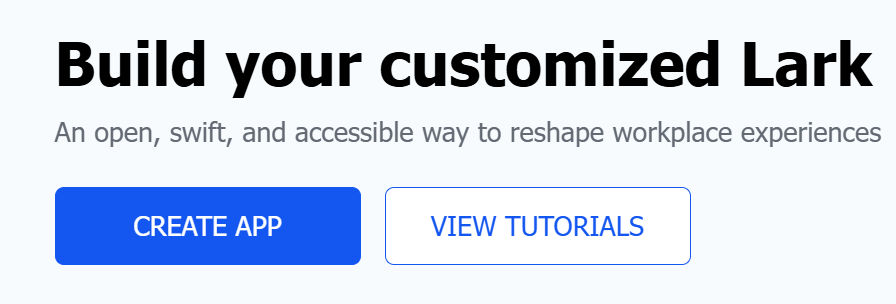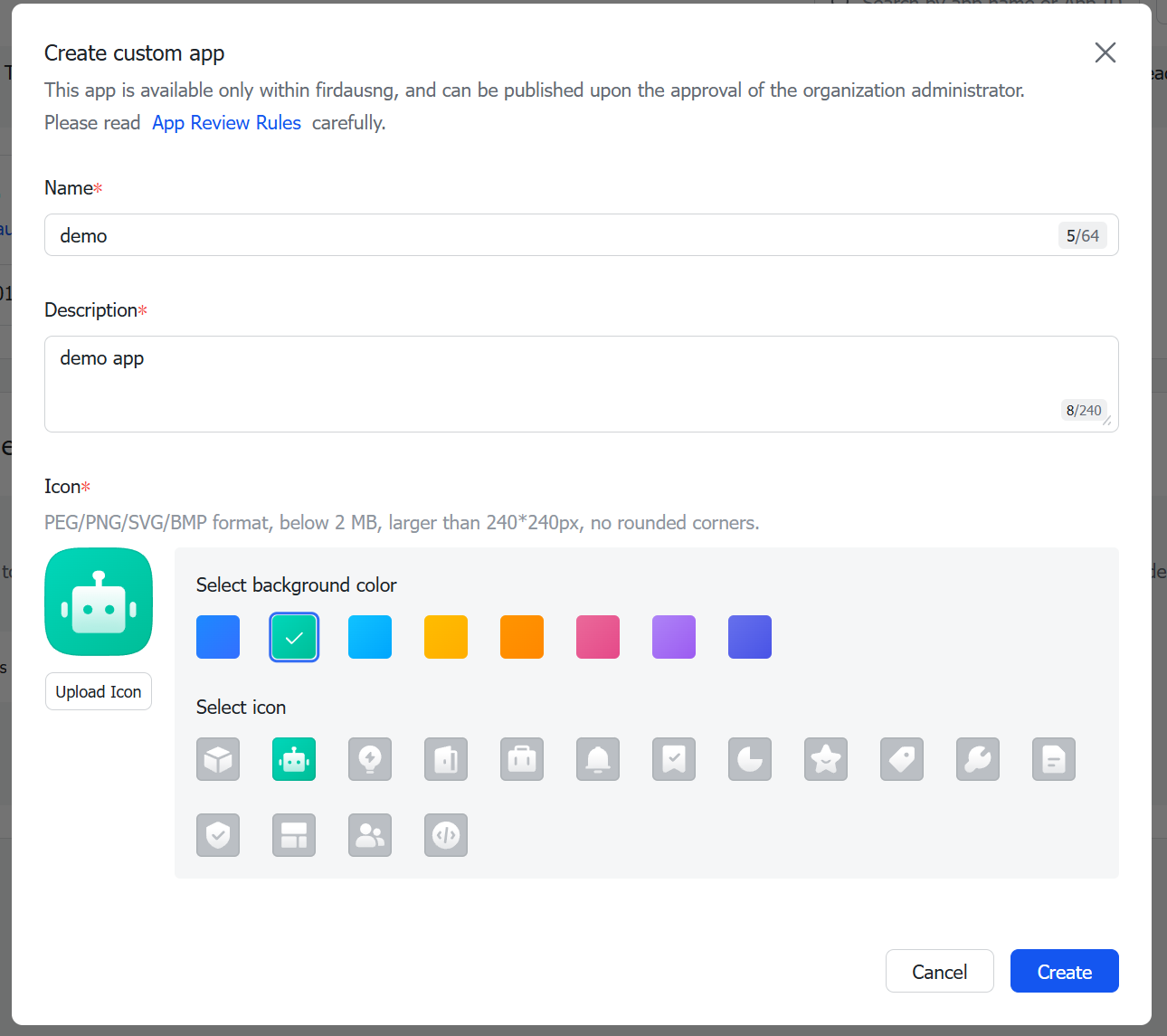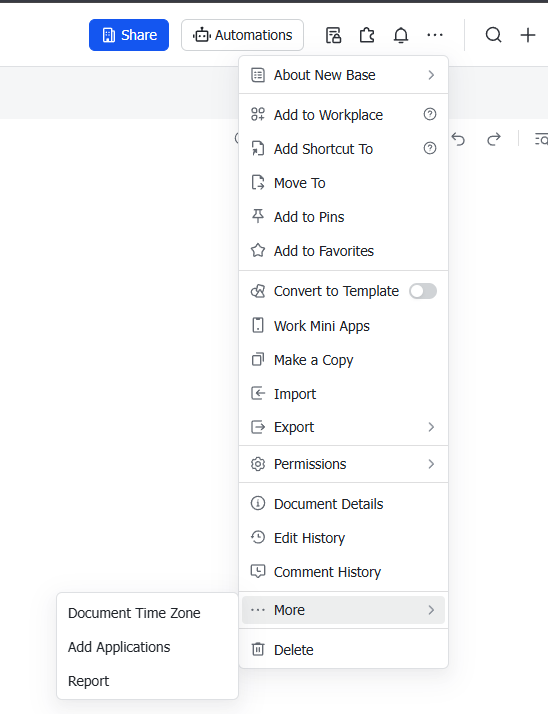Lark Suite API in Action with Hono and Cloudlfare worker: Basic Guide
Published at Jan 31, 2025
Lark Suite is a application developed by ByteDance as 1 stop solution for all business need. Lark Suite do provide a very generous free tier with many feature that can compete with the like of Google Workspace, Microsoft 365 or Zoho. Lark Suite also provide a comprehensive API that can be used to integrated with any site. In this guide, we will take a look on how to set up Lark API and integrate it with any app
Prerequisites
Before we begin, make sure you have:
- Node.js installed on your machine
Setting Up Your LarkSuite
Before you can use LarkSuite API, you need to have Lark account. You can create the account using my referral here https://open.larksuite.com Once you have Lark account, then navigate to https://open.larksuite.com/ to create the custom app. Here a brief steps on how to do that:
- Navigate to https://open.larksuite.com/
- Click create App button

- Click Create Custom App button

- fill out the app detail
 and click
and click confirm - Your app should be ready now
Test using Lark API Explorer
In order for you to test Lark API, you can go to Lark API Explorer. Here you can test all API that LarkSuite provide.
Each of the APIs have scope that you need to give before you can execute the API.
You can choose between tenant_access_token or user_access_token to choose for each APi. for some APIs, you can only used user_access_token due to the data requested such as Obtain login user information.
Manipulate Lark Sheet
One of interesting feature of Lark is Sheets.
This feature similar with Google Sheet or Microsoft Excel. Lark do have API that you can use such as Create Spreadsheet API.
In order to use this API, you need to create the sheet in Lark, and then you need to make sure that the sheet that you have created can be accessed by the app.
This can be done by adding the template to your Lark organization drive
Once do that, you need add the App that you created above to the sheet. The screenshot below show you where to do that.  This will enable your app to access that sheet using api now. To test this you can go again to Lark API Explorer and
try to run any sheet API.
This will enable your app to access that sheet using api now. To test this you can go again to Lark API Explorer and
try to run any sheet API.
Simple Hono App using LarkSuite API
If you have not yet create hono app, you can follow this guide to that. I am going to use cloudflare worker template for this.
I’m also going to use ofetch package in this guide. this can install using below command
pnpm add ofetchThen we can create a simple Lark Client as below
// src/lark-client.ts
import { ofetch } from "ofetch";
export default class LarkClient{
public tenantAccessToken: string|undefined;
constructor(private config: LarkClientConfig) {
}
async getTenantToken(){
// https://open.larksuite.com/open-apis/auth/v3/tenant_access_token/internal
const url = `${this.config.domain}/open-apis/auth/v3/tenant_access_token/internal`;
const payload = {
app_id: this.config.appId,
app_secret: this.config.appSecret,
};
const response = await ofetch<Token>(url, {
method: "POST",
headers: {
"Content-Type": "application/json",
},
body: payload,
})
.catch((err) => {
console.error("Fetching tenant_access_token failed:", (err as Error).message);
});
if(!response){
return;
}
this.tenantAccessToken = response.tenant_access_token
return response;
}
async getTable(appToken: string, pageSize = 20){
//open-apis/bitable/v1/apps/YZYab6ZzyaXFossG7bllkcxlgjd/tables?page_size=20
const url = `${this.config.domain}/open-apis/bitable/v1/apps/${appToken}/tables?page_size=${pageSize}`;
const response = await ofetch<LarkResult<Pagination<Table>>>(url, {
method: "GET",
headers: {
"Content-Type": "application/json",
"Authorization": `Bearer ${this.tenantAccessToken}`
},
})
.catch((err) => {
console.error("Fetching table failed:", (err as Error).message);
});
if(!response){
return;
}
return response; // Handle or return the response as needed
}
}
export type LarkClientConfig = {
appId: string,
appSecret: string
domain: string
}
type Token = {
"code": number,
"expire": number,
"msg": string,
"tenant_access_token": string
}
export type LarkResult<T> = {
code: number
msg: string
data: T
}
export type Pagination<T> = {
has_more: boolean
page_token: string
total: number
items: Array<T>
}
export type Table = {
table_id: string
revision: number
name: string
}In the code above, I have LarkClient class that will handle authentication and also a wrapper for Lark API.
We are also going to use Hono middleware to give instance of LarkClient to all Hono request.
Next is we going to add type for the Hono App
// src/types.d.ts
import {Hono} from "hono";
import LarkClient from "./lark-client";
export type App = {
Bindings: Env,
Variables: {
larkClient: LarkClient
}
}
export type AppOpenAPi = Hono<App>;we are putting larkClient under Variables so that each Hono request can have instance of LarkClient
Now we need to set Hono App to use this client
// src/middlewares/lark.ts
import { createMiddleware } from 'hono/factory'
import LarkClient from "../lark-client";
import {App} from "../types";
export const lark = createMiddleware<App>(async (c, next) => {
const client = new LarkClient({
domain: 'https://open.larksuite.com',
appSecret: c.env.LARK_APP_SECRET,
appId: c.env.LARK_APP_ID
})
c.set('larkClient', client)
const LARK_TENANT_KEY = 'LARK_TENANT_KEY';
const tenantKey = await c.env.MY_KV_NAMESPACE.get(LARK_TENANT_KEY);
if(!tenantKey){
const token = await client.getTenantToken();
if(token?.tenant_access_token){
const expire = (token.expire * 1000) - (3 * 60 * 1000);
console.log(`storing token: ${JSON.stringify(token)} with expiring ${expire}`)
await c.env.MY_KV_NAMESPACE.put(LARK_TENANT_KEY, token?.tenant_access_token, {
expirationTtl: expire
})
}
}else{
console.log(`use tenantkey from cache`)
client.tenantAccessToken = tenantKey;
}
await next()
})This middleware basically set LarkClient instance.
Here we’re also utilizing Cloudflare KV to store tenant key so that we do not need to request tenant key for every Hono Request.
You need to update your wrangler.toml file and .dev.vars to store all the necessary above
- LARK_APP_SECRET (.dev.vars)
- LARK_APP_ID (wrangler.toml)
- MY_KV_NAMESPACE (wrangler.toml)
All these setup will help us to integrate Lark API in Hono app. Here is the basic Hono App utilizing all the code above
import { Hono } from 'hono'
import {App} from "./types";
import {lark} from "./middlewares/lark";
import {requestId} from "hono/request-id";
import {logger} from "hono/logger";
const app = new Hono<App>()
app.use(requestId());
app.use(logger());
app.use(lark);
app.get('/:appToken', async (c) => {
const appToken= c.req.param('appToken')
const response = await c.var.larkClient.getTable(appToken)
if(!response){
return c.json({
type: "https://example.com/probs/token-error",
title: "Validation Error",
instance: c.req.path,
traceId: c.var.requestId
})
}
return c.json(response?.data)
})
app.notFound((c) => {
const json = {
type: "https://example.com/probs/not-found",
title: "Path not found",
detail: "You requested path is not exist",
instance: c.req.path,
traceId: c.var.requestId
};
return c.json(json, 404)
})
export default app
when you run the Hono App, you can send the request with appToken. This appToken should be available on your sheet.
You can get more information from this doc List Table You also can get the appToken from the url when you view the Lark Sheet, for example from https://abc.sg.larksuite.com/base/asalskakamkda
Conclusion
This guide will help you to use LarkSuite API to your application. I am using Hono as example but this can be applied in any web framework. Lark Suite is a very nice tool because it has many features. Some of the interesting feature for small business to have quite a robust app with rich features like email, Sheet.
